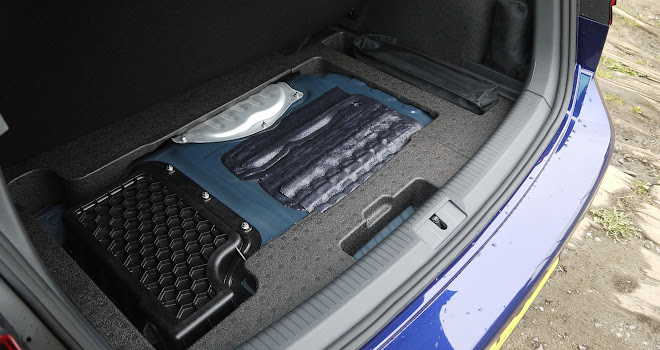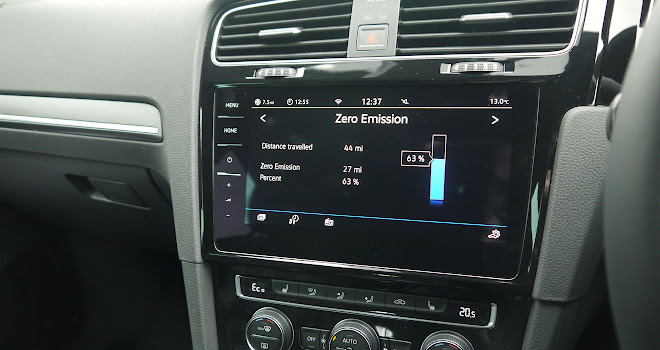
Rating: stars
Good: cheaper than the old GTE, ace digital instruments
Bad: no spare wheel, big touchscreen is pricey
Price: from £28,135 after the Plug-in Car Grant
Volkswagen has updated its seventh generation Golf to version 7.5, giving it a mild exterior facelift and some welcome interior upgrades. These vary from the latest technical doodads for hooking up to the internet to the simple elegance of a frameless rear-view mirror.
In the case of the GTE plug-in hybrid edition there’s an even more significant change – 10% off the list price. The pre-facelift Golf GTE used to cost from £34,055 whereas the newer version now starts at £30,635. Subtract the £2,500 sweetener of the Plug-in Car Grant and the GTE can now be yours for £28,135 – roughly the same as it cost two years ago, when the grant was a much more generous £5,000.
Thankfully the GTE’s appeal has not had a tenth lopped off. It remains among the top tier of plug-in cars available today, providing a feel-good sporting demeanour that’s reminiscent of the hot-hatch Golf GTI.

I say reminiscent rather than comparable because while the GTE comes close to the GTI in overall power output, it can’t keep up in other respects. The plug-in car is not only slower according to the stopwatch but also feels less agile and a lot softer in corners. Of course these outcomes are to be expected given that the GTE is about 14% heavier than the GTI, on account of its more complicated powertrain.
However, because of the petrol-electric capabilities that come with that extra weight, the GTE is an extremely versatile all-rounder. If you want to drive with vim and enthusiasm, the GTE is up for fun. And on those days when you simply want to get from A to B without fuss or wasted fuel, it’s perfect for that too.

Indeed the GTE’s personality can change completely at the push of a button. Well, two buttons. One, marked GTE, transmogrifies the car between snarling hot hatch and mild-mannered hybrid. The other, marked E-Mode, allows you to choose among EV, hybrid and battery recharging modes – the choices pop up on the screen and can be selected with a quick tap.
In pure-electric EV guise, the GTE can travel at up to 81mph without waking its petrol engine, though the distance you can cover this way is quite limited – officially the battery lasts for 31 miles but more realistically it will run out at 25, or even less if you drive too briskly. A full recharge takes 2 hours and 15 minutes from a domestic wallbox – a wait that hasn’t changed with the latest upgrades. Once the mains charge has run out the GTE behaves like any other petrol-powered hybrid, regenerating energy whenever the car slows down, then reusing it to assist acceleration later on.

Most of the actual changes to the GTE are cosmetic or equipment related. While some other models in the Golf range have received clever engine upgrades, the GTE’s plug-in hybrid system remains exactly the same as before. The same 1.4-litre four-cylinder petrol engine still provides up to 150 horsepower and 250Nm of torque. It drives the front wheels through a six-speed double-clutch automatic gearbox. Between the engine and gearbox an electric motor provides extra shove, while also regenerating electricity either from braking or by taking surplus power from the engine. When called upon the motor can provide just over 100 horsepower with peak torque of 330Nm.
Combined, the engine and motor can summon up 204 horsepower and 350Nm of torque. Acceleration to 62mph from a standstill takes just 7.6 seconds.
The layout of components under the skin hasn’t altered, so there’s still no option to carry a spare. The petrol tank is bolted under the boot floor, where other Golf models house their spare wheel. The GTE’s 8.7kWh lithium-ion battery takes up the tank’s usual home under the rear seats. Lift up the boot floor and you’ll find lumps of hardware rather than the Golf’s usual shallow storage compartment, and the fuel tank holds only 40 litres, 10 less than other models.

But of course the mains-charged battery means you ought to travel further on a litre than most other models.
Inside, the GTE is designed to resemble the GTI with its tartan seats – woven with blue rather than red stripes.
Updates include a large, bright and crisp digital instrument panel that is fitted as standard to both trim levels of the revised GTE. While the old line-up consisted of GTE and GTE Nav specifications, separated by £1,765 and some sat-nav and Car-Net connectivity gear, the range now comprises GTE and GTE Advance.

The price gap has fallen to £1,500 but happily the equipment gulf has grown a lot wider. The GTE Advance package includes privacy glass at the rear, 18-inch alloys, heated front seats and a few other bits and bobs, as well as the previous sat-nav and Car-Net upgrades. As a result the higher trim level seems a lot more tempting.
Perhaps surprisingly, sat-nav remains an upgrade option for the base GTE – it costs £765 to add it to the car’s standard 8-inch touchscreen. That screen is the same size as in the old car but looks bigger and a lot more glossy due to a seamless glass fascia that includes new touch-sensitive buttons.

There’s also now the option of a big 9.2-inch central screen with higher definition graphics and gesture control. The latter feature allows you to wave your hand at the screen instead of swiping left-to-right, which can greatly reduce the need to take your eyes off the road.
The feature works surprisingly well for changing radio stations or skipping songs, but alas you can’t gesture up and down to scroll through longer menus or change the volume, say. There are wheel buttons to control most things you can’t gesture at, and thankfully the heater controls remain in hardware and have not migrated onto the screen.
The upgraded console screen is impressive but I’m not sure it’s quite impressive enough to justify its £2,090 cost (or £1,325 in the case of the GTE Advance). Call me tight-fisted if you like.

The ability to display a fairly large chunk of sat-nav map in the instrument panel is a much more valuable advance. The twin dials can be made large or small to suit, and it’s also possible to configure what supplementary data you’d like to have in front of you via menus controlled through the wheel buttons. I’d still prefer a head-up display, but that’s yet to arrive as an option for any Golf.
The left-hand instrument dial tells you what demands you’re making of the car, letting you know the battery’s state of charge, when the engine is about to wake up and also showing how much regeneration potential you’re using under braking.
You can override the automatic transmission using paddles behind the wheel if you want to prepare for overtaking, for example. Tugging the gearlever, which selects Sport mode in many other automatic Golfs, in the GTE instead toggles between a D and B driving mode. D, the standard setting, provides quite gentle engine braking when you release the throttle, whereas B will try to regenerate as much energy as possible.

The B setting is useful for descending steep hills but can be used all the time if you like the feel of one-pedal driving, where you control speed on the throttle and hardly ever need to touch the brakes. BMW has set up its i3 electric car to work this way by default, presumably because heavy regeneration is more efficient.
The model pictured is the GTE Advance trim level and I’m happy to report that the 18-inch wheels don’t ruin the car’s ride, though they do add 2g/km to the car’s official CO2 score. The Advance edition is rated at 40g/km while the standard GTE on 17-inch alloys scores 38g/km. A small increase in fuel consumption is likely to be felt in the real world as well.
Overall, the GTE remains a very enjoyable car to drive, combining most of the fun of a hot hatch with the frugal capabilities of an EV over short distances. Now both cheaper and better equipped than before, it’s a hard car not to like.









